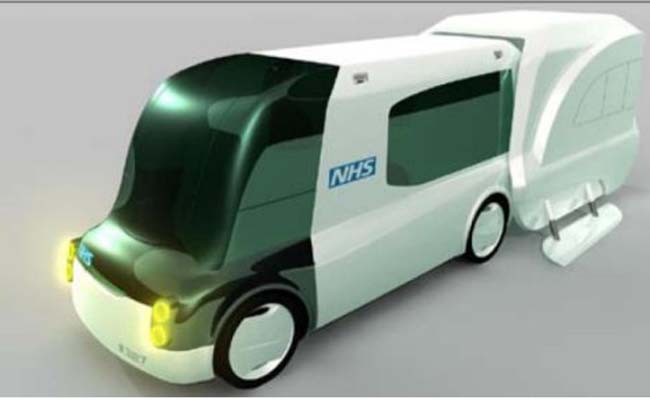
May 31, 2013
Ambulance of the Future
Designing mobile health care is a challenge of space, speed, and flexibility.
There’s lots of exciting design coming out of hospitals, like the one we wrote about this month, “Healing Machine.” In fact, it looks like technological and practical revisions will soon make time spent in health-care situations more comfortable for nurses, doctors, visitors, and patients alike.
Similarly, those who are the first responders to medical situations—EMTs and police and fire department officers—are helping designers come up with more efficient and more useful designs for mobile health care, AKA ambulances.
The “ambulance of the future” is a complex challenge that can take a variety of forms. An emergency medical response vehicle can focus one or more issues currently problematic in ambulance design, including accessing remote locales, addressing medical issues on-site (instead of simply transporting a person to a hospital), or allowing EMTs to work more safely while the ambulance is in motion.

In Healthcare on the Move: The Smartpod Project (funded by the U.K.’s Engineering and Physical Sciences Research Council and shown at the Royal College of Art (RCA)). designs for ambulances were focused around the idea that treating patients on scene, rather than rushing them to a hospital, will result in better outcomes. RCA designer Rob Thompson told BBC News, “Up to 50 percent of people who dial 999 in an emergency could be treated at home by a rare breed of paramedic, an Emergency Care Practitioner (ECP). They have been trained with the skills needed to treat and diagnose a patient on scene rather than run them to hospital.”
The Shell Concept design from the RCA Smartpod project put vehicle speed in the backseat and instead looked at bringing services like x-rays, immunizations, and screenings to a modular ambulance with a shell that pulls out from the rear of the vehicle. For combat or rural emergency response, another proposal included a deployable tent, allowing 360-degree access to a patient (impossible in a typical ambulance set-up) while a fourth, with giant wheels, looked at an ambulance that could travel as fast off-road as on.
Taking a different tack, the giant Airship Archangel could navigate into bombed-out conflict areas or those affected by natural disasters, bringing with it everything that could be needed on-board. Designed by Thomas Grimm, with design support from Reindy Allendra and technical support from Dr. Gregory Smedley, the ship brings with it the capability of a medical center. It can be tethered and run on local power, or provide its own with wind generated energy (and can even serve as a source of emergency power), it can fly in high wind speeds (up to 80 knots), and can include bringing cargo (food and clean water) as well as medical supplies to affected areas more quickly than using possibly destroyed roads or bridges.
While on-board medical systems that can help paramedics start treating patients are a boon, direct contact with specialist doctors can mean the difference between life or death. Lifebot Technology’s SuperAmbulance is outfitted with Hewlett-Packard computers, cameras and a special Slate tablet that allows direct communication between EMTs and emergency or trauma doctors at the hospital.
This telemedicine device combines GPS positioning, high-res imaging, patient history and medical record access and direct contact between doctor and patient, remotely. A specialist physician can move the cameras in the vehicle as it speeds to the hospital, make specific recommendations to crew treating the patient, and even monitor vital signs. At $50,000 it’s an expensive system, but is ideal for rural areas (where care could be 30 or 40 miles away or more), and is already in limited use in areas of Arizona, Florida, and Texas.
Starre Vartan is an author, journalist, and artist whose work concentrates on sustainability in consumer products, including a focus on vernacular, nature-based and eco design. Recognized as a green living expert, she is the publisher of Eco-chick.com, a columnist at MNN.com, and contributes to Inhabitat and The Huffington Post. She is Metropolis’s copyeditor.





